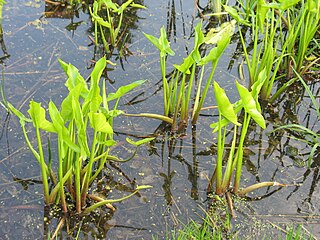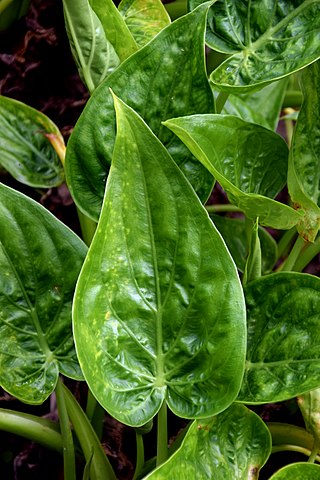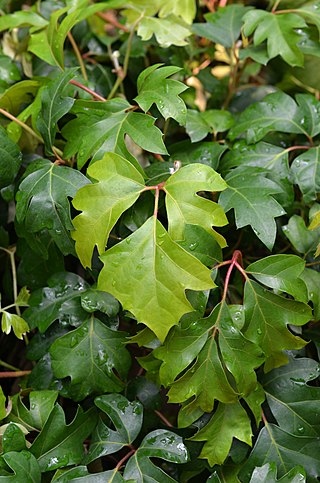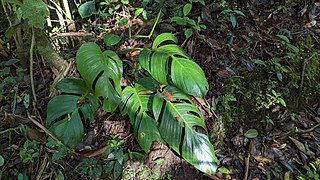
Amorphophallus is a large genus of some 200 tropical and subtropical tuberous herbaceous plants from the Arum family (Araceae), native to Asia, Africa, Australia and various oceanic islands. A few species are edible as "famine foods" after careful preparation to remove irritating chemicals. The genus includes the Titan arum of Indonesia, which has the largest inflorescence of any plant in the genus, and is also known as the 'corpse flower' for the pungent odour it produces during its flowering period, which can take up to seven years of growth before it occurs.

Monstera deliciosa, the Swiss cheese plant or split-leaf philodendron is a species of flowering plant native to tropical forests of southern Mexico, south to Panama. It has been introduced to many tropical areas, and has become a mildly invasive species in Hawaii, Seychelles, Ascension Island and the Society Islands. It is very widely grown in temperate zones as a houseplant.

Monstera is a genus of 59 species of flowering plants in the arum family, Araceae, native to tropical regions of central and south America.

Spathiphyllum wallisii, commonly known as peace lily, white sails, or spathe flower, is a very popular indoor house plant of the family Araceae. The genus name means "spathe-leaf", and the specific epithet is named after Gustav Wallis, the German plant collector. It was first described in 1877.

Peltandra virginica is a plant of the arum family known as green arrow arum and tuckahoe. It is widely distributed in wetlands in the eastern United States, as well as in Quebec, Ontario, and Cuba. It is common in central Florida including the Everglades and along the Gulf Coast. Its rhizomes are tolerant to low oxygen levels found in wetland soils. It can be found elsewhere in North America as an introduced species and often an invasive plant.

Arisarum vulgare, common name the friar's cowl or larus, is an herbaceous, perennial, rhizomatous plant in the genus Arisarum belonging to the family Araceae.

Monstera punctulata is a species of flowering plant from the family Araceae found in the southern part of Mexico and in Central America.

Alocasia cucullata is a species of flowering plant in the arum family known by the common names Chinese taro, Chinese ape, Buddha's hand, and hooded dwarf elephant ear. It is kept as an ornamental plant.
Salix daliensis is a shrub from the genus of willows (Salix) with mostly 5 to 6 centimeters long leaf blades. The natural range of the species is in China.
Salix dissa is a low shrub from the genus willow (Salix) with usually 1 to 3 centimeters long leaf blades. The natural range of the species is in China.
Salix divergentistyla is a shrub or tree from the genus of willow (Salix) with mostly 3 to 4.5 centimeters long leaf blades. The natural range of the species is in Tibet.
Salix doii is a shrub from the genus of the willow (Salix) with mostly 3 to 4 centimeters long leaf blades. The natural range of the species is in Taiwan.

Salix erioclada is a species from the genus of willows (Salix) and grows as a shrub or small tree. The leaf blades have a length of about 5 centimeters. The natural range of the species is in China.

Cissus alata, commonly known as grape ivy, grape leaf ivy, oak leaf ivy, or Venezuela treebine, is a species of flowering plant in the family Vitaceae native to the tropical Americas. Under its synonym Cissus rhombifolia, it has gained the Royal Horticultural Society's Award of Garden Merit. The species name 'alata' means winged.
Monstera juliusii is a flowering plant in the family Araceae. It is native to high-altitude cloud forests of Costa Rica at altitudes of 1,600 to 2,250 metres and occasionally confused with Monstera standleyana. However, M. standleyana has green petioles, few fenestrations and thin leaves, while M. juliusii is characterized by mottled white petioles, frequent fenestrations at maturity and thick, leathery leaves. Mature plants have pinnatilobed leaves as long as 60 cm and 30 cm wide, with circular fenestrations close to the margins, and oval fenestrations near the midrib. The species is named after Julius Johnson, son of the artists Rashid Johnson and Sheree Hovsepian.

Monstera monteverdensis is a species of flowering plant in the arum family, Araceae. Its adult form is characterized by pinnatifid margins with up to eight lobes per side, with occasional fenestrations away from the midrib. Leaves can grow as large as 60 cm long and 30 cm wide. It is named after the city of Monteverde, where the species is abundant.
Monstera alfaroi is a flowering plant in the arum family. It is endemic to mid-altitude premontane rainforests of Costa Rica at altitudes of 1,100 to 1,250 metres. M. alfaroi features light brown petioles with black or white warts. It is closely related to Monstera buseyi, but M. alfaroi can be distinguished by its larger inflorescence. M. alfaroi is also easily confused with M. costaricensis, which can be distinguished from M. alfaroi by its petioles with white pustules, more conical inflorescence, and location; M. costaricensis only occurs in lowland areas of Costa Rica below 600 metres (2,000 ft). Mature plants have ovate leaf blades as long as 90 centimetres (35 in) and 45 centimetres (18 in) wide, with few circular fenestrations near the midrib. From petiole to blade tip, M. alfaroi leaves can be up to 160 centimetres (63 in) long. It has a white spadix and an externally light green spathe. Flowering has been recorded in November, and fruiting in January.

Philodendron opacum is a species of flowering plant. It has a native range extending from Southeast Nicaragua to Ecuador and includes Colombia, Costa Rica, Ecuador, Nicaragua, Panama. Its habitat is largely restricted to the Tropical Wet Forest and Premontane Wet Forest life zones in Central America, but in South America extends into Premontane Rain Forest (Colombia) and Tropical Moist Forest (Ecuador).
Monstera croatii is a flowering plant in the family Araceae. It is endemic to Costa Rica at altitudes of 300-600 meters. It is unique within the genus for being a primarily terrestrial grower, able to reach adult size without an epiphytic growth habit, whereas other monstera will remain in a creeping juvenile state until finding a suitable media for climbing and maturing. It will typically climb up to one meter before flowering. Adult plants have smooth, blue-tinged green petioles up to 45 centimeters long, with oblong, deeply pinnatifid leaf blades up to 45 centimeters long and 33 centimeters (13) wide. Adult specimens do not form fenestrations. Its spathe is up to 14 centimeters long, externally white-yellow at anthesis, with a white spadix 8 centimeters long. Mature fruits and seeds have not been observed, and no fertile specimens have been collected to date. M. croatii has immature infructescences recorded in February, with flowers observed in October and November.

Monstera praetermissa is a species of plant in the genus Monstera native to Brazil. It grows in wet tropical forests from 50–900 metres (160–2,950 ft) in elevation. It is most similar to Monstera obliqua and Monstera xanthospatha, but differs from these in habitat (Brazil) and in its inflorescence. Like many in its genus, the species transitions from a juvenile leaf shape, typically at about 15 centimetres (5.9 in) in growth, to an adult leaf that has up to five perforations per side. Its species name means "overlooked" in Latin, due to its only recent scientific description in 2004 and lack of attention from collectors.













